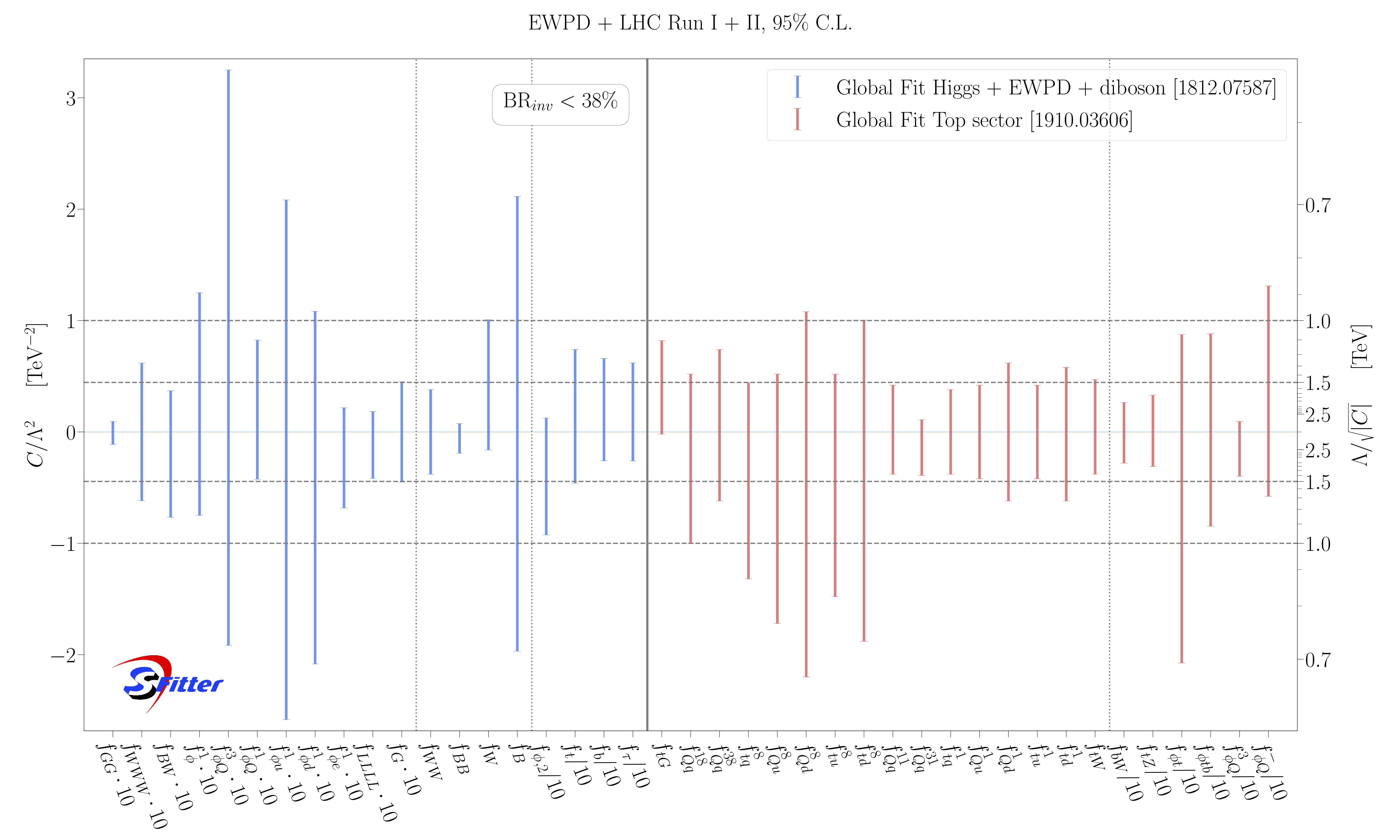|
|
Precision Higgs physics at the LHC
The Higgs boson in the Standard Model is not only the last
particle to be discovered (essentially triggering the construction of
the LHC), it is also unique in many ways. One of its exciting aspects
is that for all Standard Model particles the couplings to the Higgs
boson are fixed - they have to be proportinal to the particle's mass.
Any deviation from this structure points to physics beyond the
Standard Model, including predictions of new and unknown physical
states.
Higgs physics at the LHC offers two unique opportunities to test
the Standard Model. First, the Higgs potential is one of very few
windows to couple new particles to the Standard Model without spoiling
renormalizability. This effect is called the Higgs portal and would
appear as a uniform modification of all Higgs coupling. Second, two of
the Higgs work horses at the LHC, the Higgs couplings to gluons and to
photons, do not exist at tree level. Both operators are induced
through quantum effects. In the Standard Model, they are dominated by
effects from the top quark and the W boson, with some contributions
from the bottom quark and the tau lepton. New particles which either
get their mass through the Higgs mechanism or appear in the scalar
Higgs potential will be observable in these two couplings.
SFitter is our general tool to connect physics models with a large
number of parameters with a correspondingly large number of
measurements. Do not call it `fitting tool', because there is so much
more it can (and should) do. For instance, it unfolds the many
correlated ways the different Higgs couplings affect the observed
counting rates in the different LHC channels. This includes correlated
statistical, systematic, and theory uncertainties. The SFitter output
is a global log-likelihood map plus a detailed local study of its
maxima.
The theory framework we are using for our analysis is inspired by
effective field theory. In the so-called Higgs effective theory (HEFT)
we allow for modified Higgs interactions without accounting for the
gauge structure of the Standard Model. This way we arrive at a setup
essentially identical to the original Higgs couplings
modifications. Alternatively, we can embed the Higgs field in weak
doublets and link Higgs and weak boson signatures in the Standard
Model effective theory (SMEFT). In both cases we can determing the
coupling modifications or Wilson coefficients with SFitter.
This homepage collects Fitter results on the Higgs sector. As the
theorists on the SFitter project we (Anke Biekötter, Ilaria Brivio,
Sebastian Bruggisser, Anja Butter, Juan
Gonzalez-Fraile, Michael Rauch, and me) would like to thank our ATLAS
collaborators Remi Lafaye and Dirk Zerwas as well as our CMS
collaborator Markus Klute for the great collaboration. Some of the
material shown below is made by theorists for theorists, i.e. it might
include published but preliminary experimental results. If you use any
of the results shown here, please refer to the paper where the
corresponding official result is published and to this website as the
actual source.
If you are interested in talking to us or in collaborating with us,
please drop us an email.
Comparison of Profile likelihood vs marginalization for the Run II legacy analysis (2022) We compare profiling and marginalization of nuisance parameters and of Wilson coefficients using the same dataset and the same fully exclusive likelihood. We find that localized downward fluctuations in kinematic distributions lead to different results from the two setups, because of the complex correlations required to accomodate such an underfluctuation. |
 |
Comparison of global SMEFT and model analyses based on Run II (2021) We perform a global analysis of LHC and electroweak precision data to derive limits based on a SMEFT analysis combined with one-loop matching and compare them to limits from a direct analysis. We find that the choice of matching scale adds a sizeable theory uncertainty to this analysis. We also find that it is not guaranteed that transformed SMEFT limits are competitive with specific model searches over the model parameter space. |
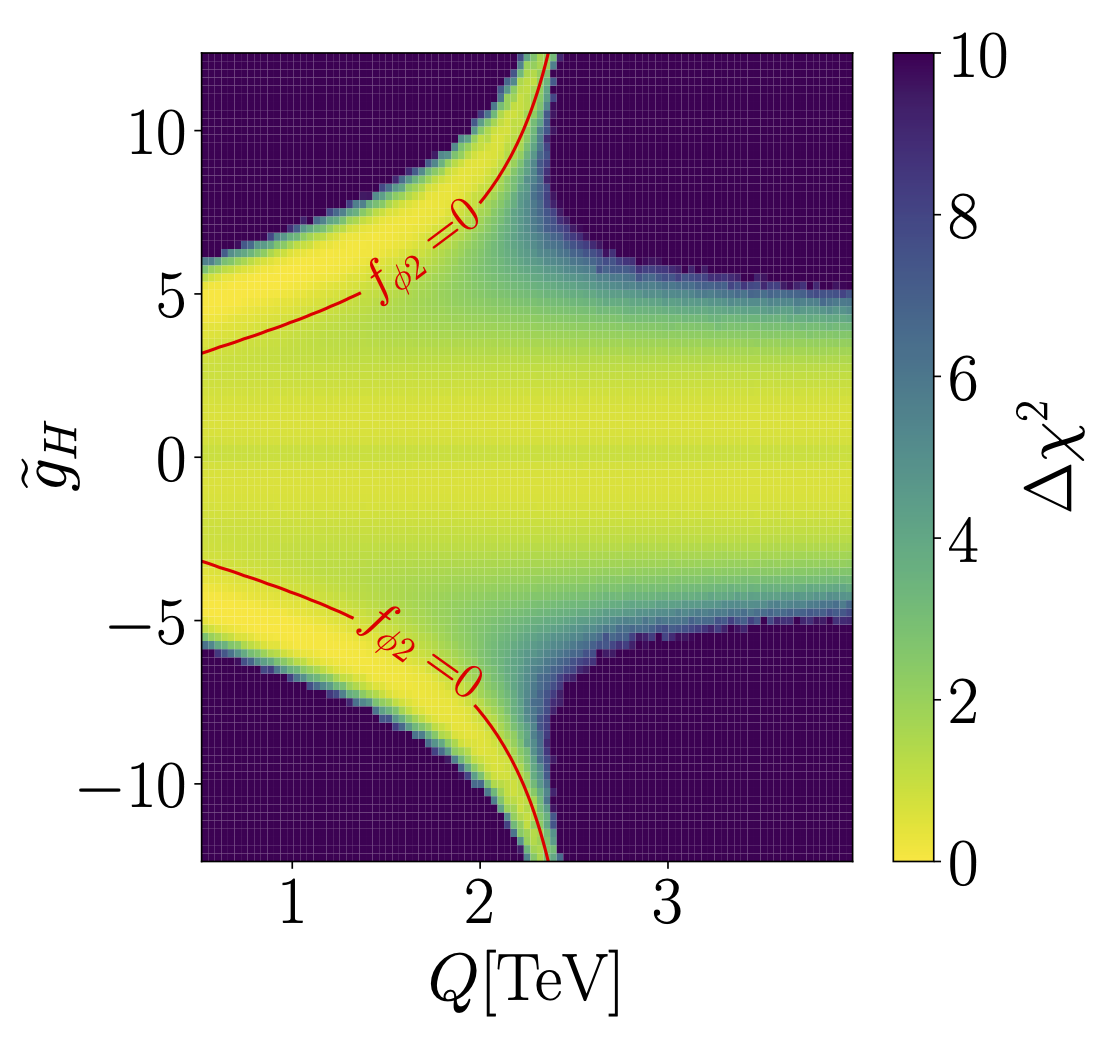 |
Top legacy of Run II (2019) in terms of the SMEFT Lagrangian We apply the usual SFitter analysis to NLO predictions from MadGraph for the top sector, including top pair production, single top production, top pair production in association with weak bosons, and top decays. Leading constraints come again from differential distributions. For meaningful limits on 4-fermion operators it is crucial that we include dimension-6 squared terms, leading to compact blind directions. |
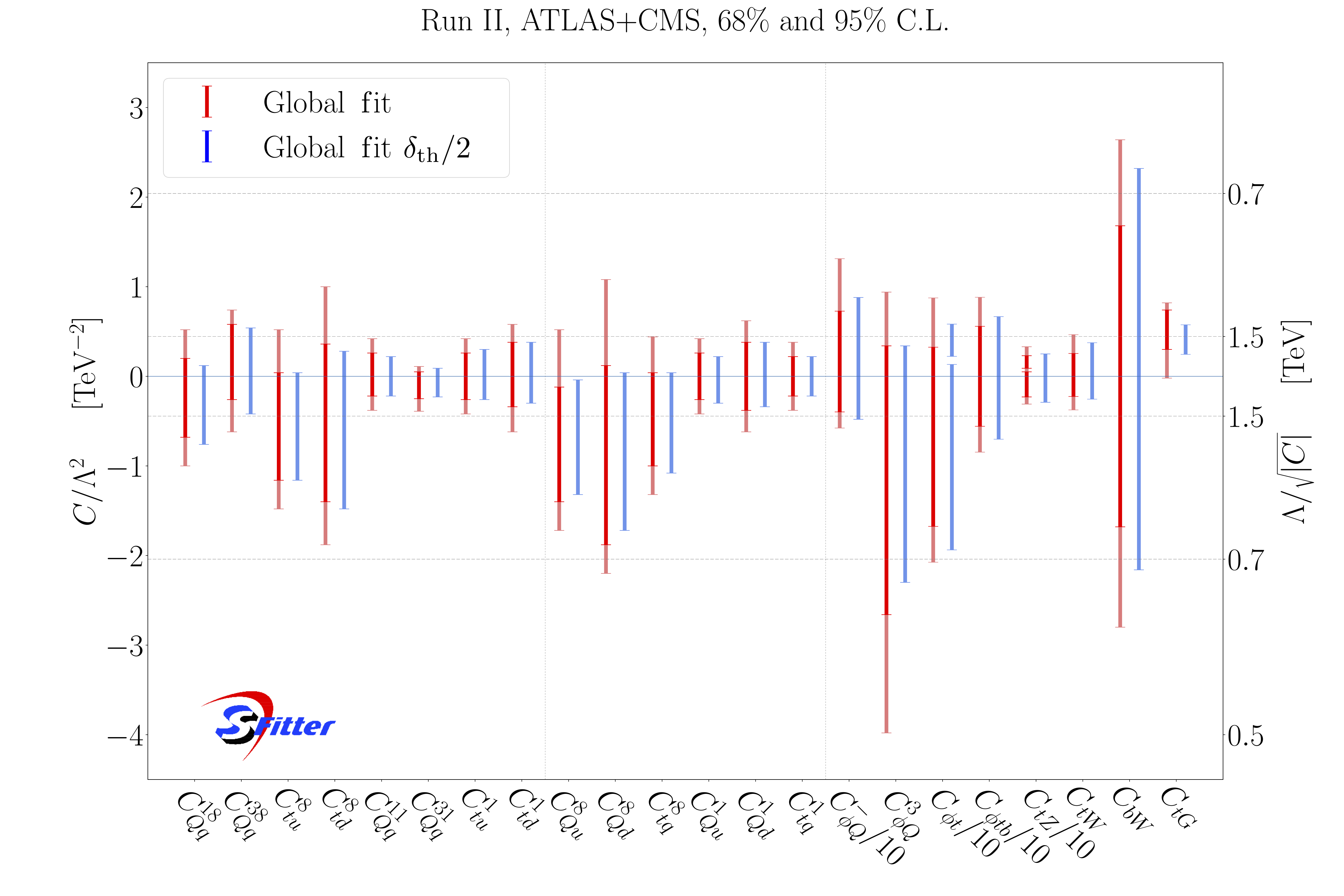 |
SFitter-Higgs and gauge legacy of Run II (2018) in terms of the SMEFT Lagrangian We include gauge boson pair production as well as electroweak precision data in a combined analysis of the dimension-6 Lagrangian. Leading constraints come from differential distributions in gauge boson pair production and in associated Higgs production. For Higgs-top and triple gluon couplings we quote the leading constraints after checking that their effect on the Higgs analysis is suppressed. |
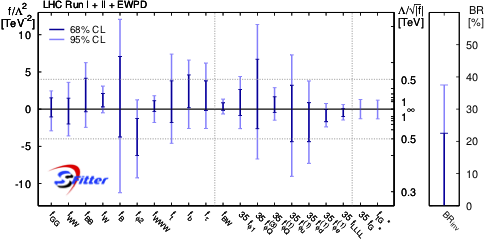 |
SFitter-Higgs and gauge projection for a 27 TeV hadron collider (2018) We combine an extrapolation of the Run I legacy with new results for Higgs pair production and invisible Higgs decays. For the latter we account for the full set of SMEFT operators. |
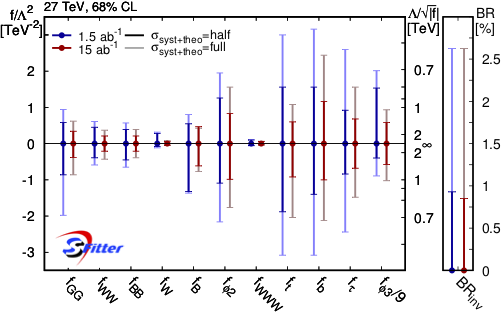 |
SFitter-Higgs projection of Higgs couplings measurements at future Higgs factories (2017) This is an update of our earlier ILC analysis, now including a circular setup. We use the non-linear HEFT or coupling modifications to avoid assumptions on the custodial symmetry, which are built into the dimension-6 SMEFT Lagrangian. It's the eternal battle between linear and circular, energy and luminosity... |
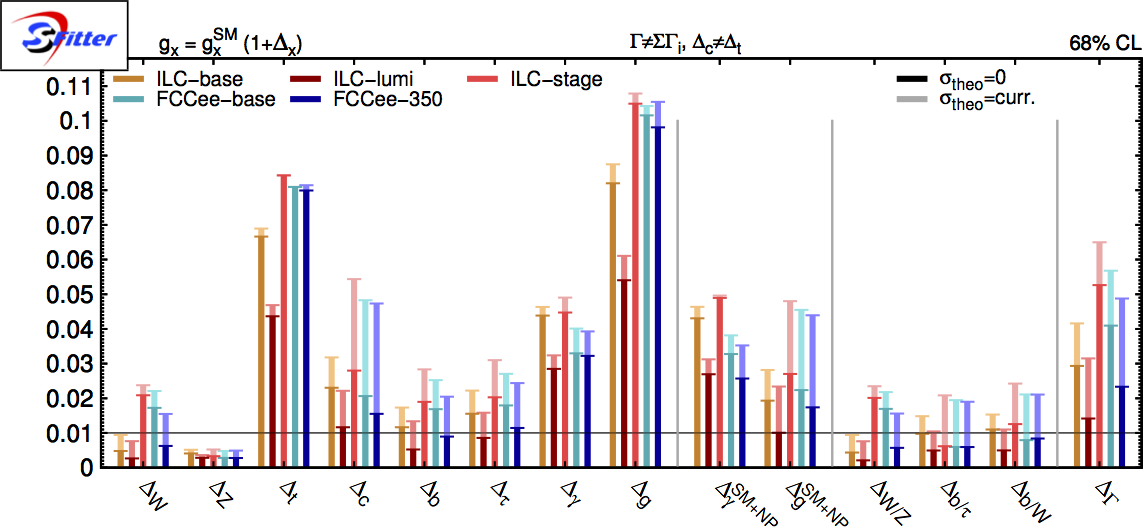 |
SFitter-Higgs and gauge legacy of Run I (2016) in terms of the SMEFT Lagrangian In addition to the full available set of Higgs results at 7 TeV and 8 TeV we also include gauge boson pair production in a combined analysis of the dimension-6 Lagrangian. This way we combine Higgs precision physics with anomalous triple gauge couplings in the appropriate framework. The combination of anomalous gauge coupling measurements is our own, and we show how LHC has passed LEP in terms of precision on the corresponding Wilson coefficients. Adding triple gauge couplings to Higgs measurements removes most of the challenging correlations between limits on different Wilson coefficients. |
 |
SFitter-Higgs legacy of Run I (2015) in terms of the HEFT Lagrangian For the full Run I data set we show how the results of the Higgs couplings analysis can be translated into Wilson coefficients of the non-linear HEFT Lagrangian. This study is not published separately and can be viewed as a simple addendum to the Higgs legacy paper. |
 |
SFitter-Higgs legacy of Run I (2015) in terms of modified Higgs couplings and the SMEFT Lagrangian We include the full available set of 7 TeV and 8 TeV results and analyse both Lagrangians using the same data. In addition to the usual total rate measurements we for the first time include invisible Higgs decays. For the SMEFT analysis we include some kinematic distributions, as well as off-shell Higgs production. |
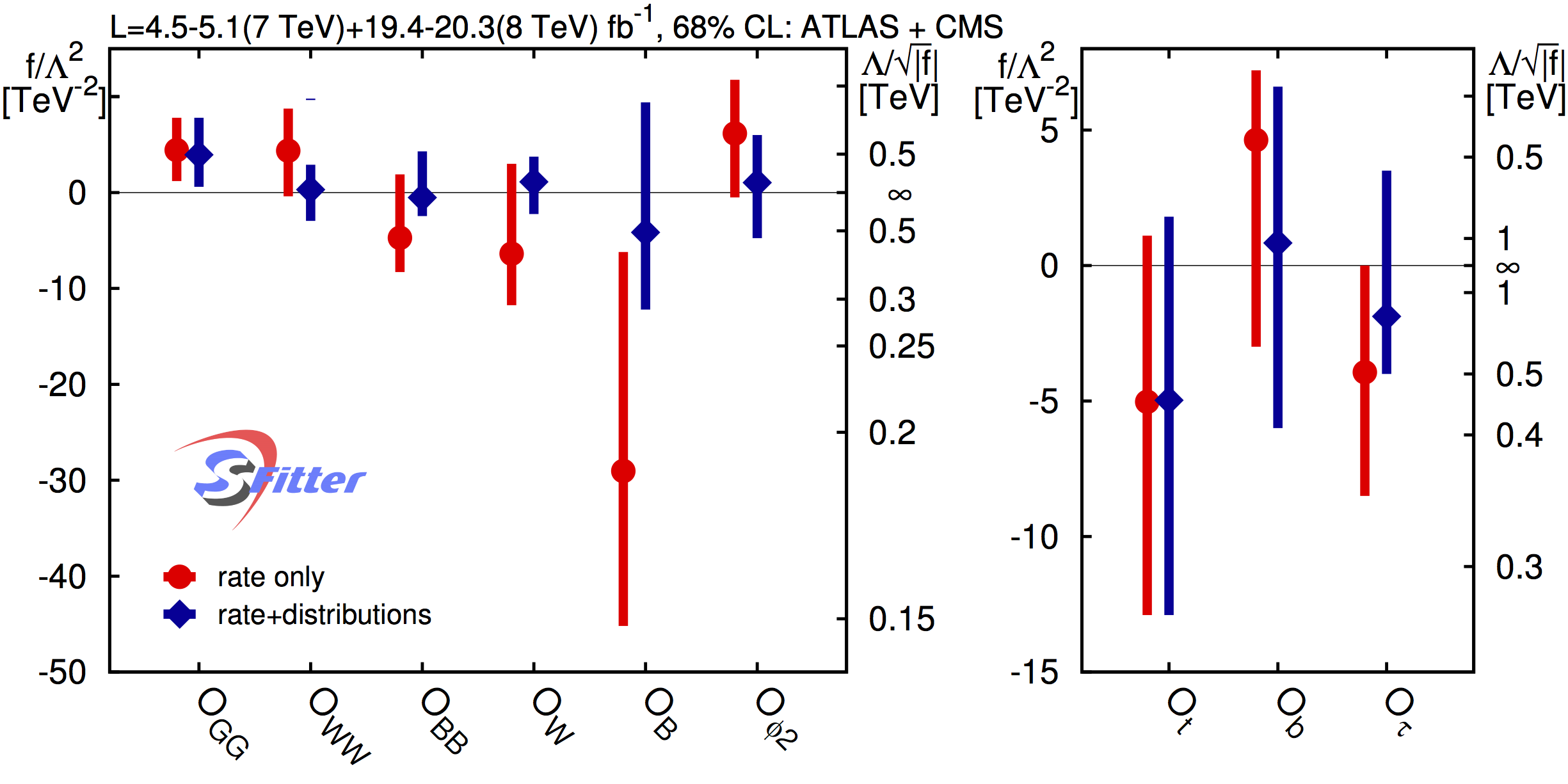 |
SFitter-Higgs update after Moriond and Aspen 2013 and two-Higgs-doublet model analysis The result includes the new di-photon rate by CMS. As usual, in additional to the universal coupling modification, the second and third entries show the results for a universal gauge boson and fermion coupling. To the right we show the ratio of couplings extracted from data. The paper also gives a detailed analysis for two-Higgs-doublet models. |
 |
Sfitter-Higgs projection of Higgs coupling measurements at a high-luminosity LHC and a LC Higgs factory The LHC analysis includes a full extrapolation of all experimental and theoretical uncertainties, including the appropriate likelihood treatment of flat theory uncertainties. We also show the crucial combination of LHC and LC measurements for example for the effective Higgs-photon coupling. Note that the main advantage of a linear collider, the actual measurement of the total Higgs width, does not enter this figure. |
 |
SFitter-Higgs update, based on 2011 (7 TeV) and 2012 (8 TeV) data as published after ICHEP 2012 For the first time, it includes all tree level Higgs couplings and an additional variable coupling of the Higgs boson to two photons (light blue). In additional to the universal coupling modification, the second and third entries show the results for a universal gauge boson and fermion coupling. |
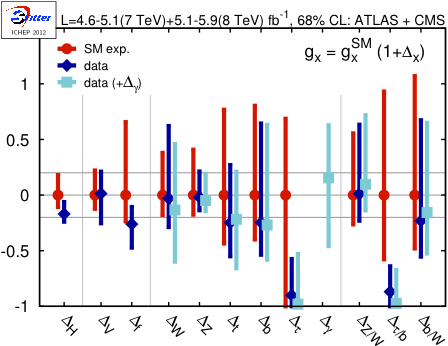 |
Projections included in the same publication, based on 2011 data (7 TeV) as published after Moriond 2012 For all scenarios we show the expected measurements, i.e. assuming measurements of the Standard Model central values but with proper error bars. As a direct measurement of the bottom Yukawa couplings we include the boosted VH analysis as estimated in the ATLAS full simulation alaysis. |
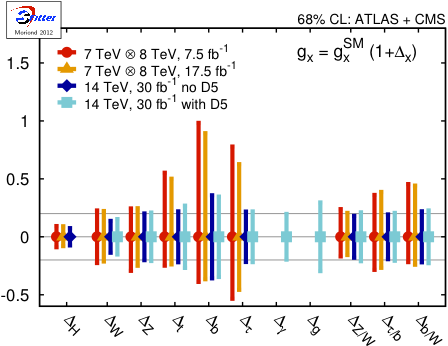 |
First SFitter-Higgs publication, based on 2011 data (7 TeV) as published after Moriond 2012 It includes the different tree level Higgs couplings as well as some ratios. The first entry corresponds to a universal form factor modification of all Higgs couplings. The three sets correspond to expected measurements (red), observed measurements (dark blue), and observed measurements with equal W and Z couplings (light blue). |
 |
SFitter-Higgs setup, from 2009 using assumed LHC data We present the SFitter structure, the basic ingredients of our error analysis, the physics assumptions behind the modified Higgs couplings, and a comparison of a likelihood vs Bayesian approach. |
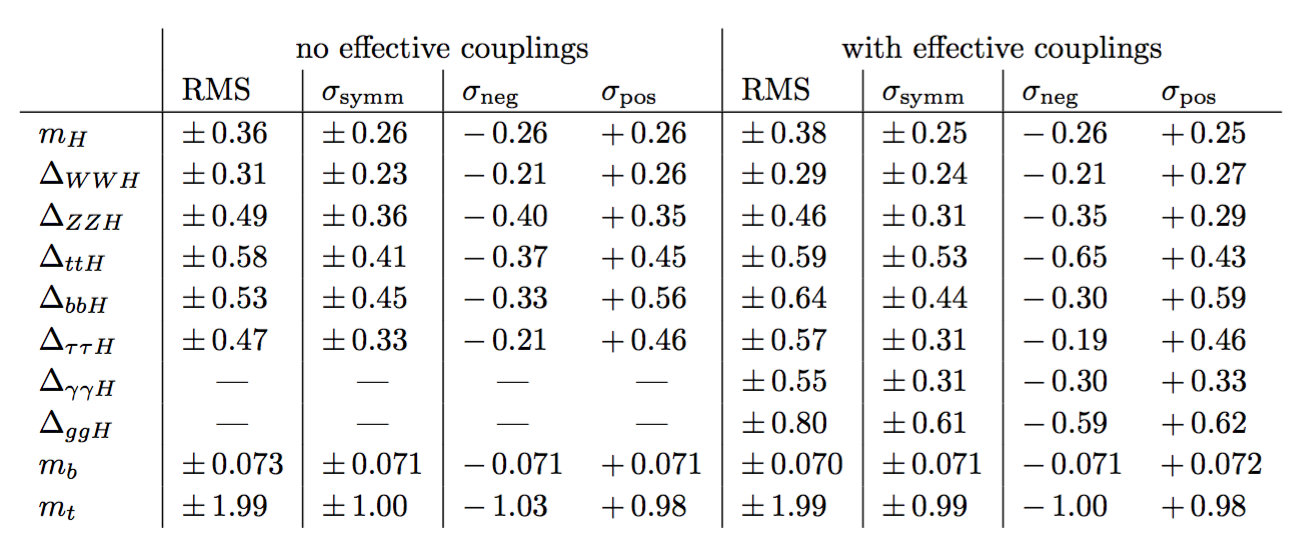 |
| related SFitter publications | |
|
Extended analysis including the 750 GeV anomaly | |
|
Link between the Fermi-LAT galactic center access and invisible Higgs decays | |
|
SFitter setup (SUSY) | |
| Further reading | |
|
Higgs and QCD lecture notes |



